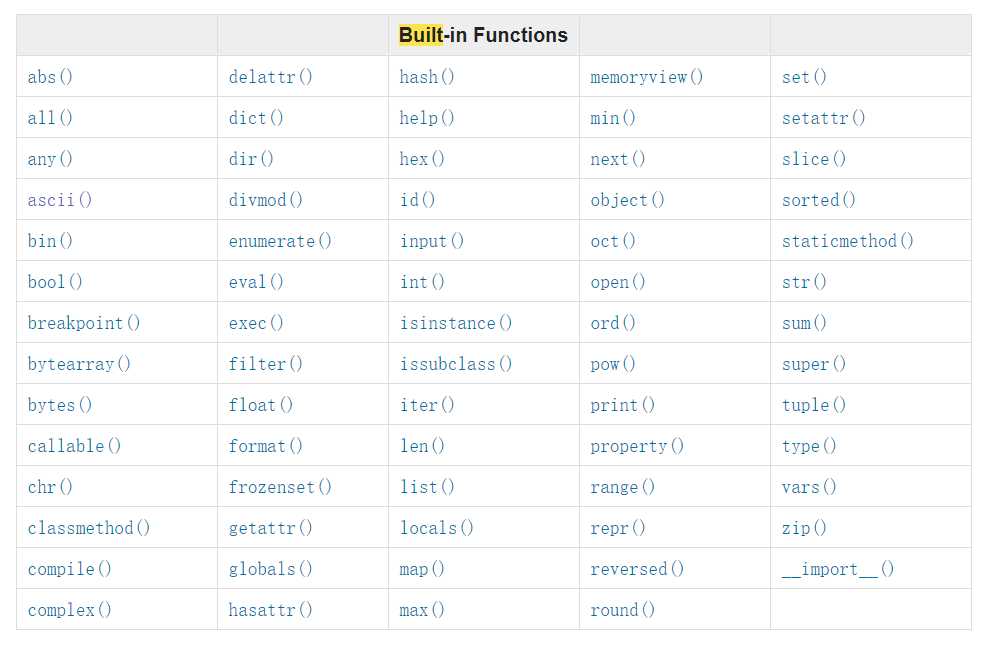python内置函数
Posted chenziqing
tags:
篇首语:本文由小常识网(cha138.com)小编为大家整理,主要介绍了python内置函数相关的知识,希望对你有一定的参考价值。
内置函数
一、内置函数
更多内置函数:https://docs.python.org/3/library/functions.html?highlight=built#ascii

1.1 掌握
bytes()
解码字符。
res = '你好'.encode('utf8') print(res) #输出: b'\\xe4\\xbd\\xa0\\xe5\\xa5\\xbd'chr()/ord()
chr()参考ASCII码表将数字转成对应字符,ord()将字符转换成对应的数字。
print(chr(65)) print(ord('A')) #输出: A 65divmod()分栏
print(divmod(10,3)) #输出: (3,1)enumerate()带有索引的迭代
l=['a','b','c'] for i in enumerate(l): print(i) #输出: (0, 'a') (1, 'b') (2, 'c')l=['a','b','c'] for index,i in enumerate(l): print(index,i) #输出: 0 a 1 b 2 ceval()把字符串翻译成数据类型。
l="['a','b','c']" print(l) print(type(l)) print(eval(l)) print(type(eval(l))) #输出: ['a','b','c'] <class 'str'> ['a', 'b', 'c'] <class 'list'>hash()是否可哈希。
print(hash(1)) #输出: 11.2了解
abs()求绝对值
print(abs(-13)) #输出: 13all()可迭代对象内元素全为真,则返回真
print(all([1,2,3,0])) print(all([])) #输出: False Trueany()可迭代对象中有一元素为真,则为真。
print(any([1,2,3,0])) print(any([])) #输出: True Falsebin()/oct()/hex()二进制、八进制、十六进制转换。
print(bin(17)) print(oct(17)) print(hex(17)) #输出: 0b10001 0o21 0x11dir()列举出所有time的功能
import time print(dir(time)) #输出: ['_STRUCT_TM_ITEMS', '__doc__', '__loader__', '__name__', '__package__', '__spec__', 'altzone', 'asctime', 'clock', 'ctime', 'daylight', 'get_clock_info', 'gmtime', 'localtime', 'mktime', 'monotonic', 'monotonic_ns', 'perf_counter', 'perf_counter_ns', 'process_time', 'process_time_ns', 'sleep', 'strftime', 'strptime', 'struct_time', 'thread_time', 'thread_time_ns', 'time', 'time_ns', 'timezone', 'tzname']frozenset()不可变集合。
s = frozenset(1,2,3) print(s) #输出: frozenset(1, 2, 3)globals()/loacals()查看全局名字,查看局部名字
def func(): a = 1 print(locals()) func() #输出: 'a': 1def func(): a = 1 print(globals()) func() #输出: '__name__': '__main__', '__doc__': None, '__package__': None, '__loader__': <_frozen_importlib_external.SourceFileLoader object at 0x000001AD03175B08>, '__spec__': None, '__annotations__': , '__builtins__': <module 'builtins' (built-in)>, '__file__': 'F:/python学习/测试/测试2.py', '__cached__': None, 'func': <function func at 0x000001AD04E67048>pow()平方
print(pow(2,4)) print(pow(3,2,2))# (3**2)%2 #输出: 16 1round()四舍五入
print(round(3.56)) #输出: 4slice()切片
lis = ['a', 'b', 'c'] s = slice(1, 4, 1) print(lis[s]) # print(lis[1:4:1]) #输出: ['b', 'c']sum()求和
print(sum(range(100))) #输出: 4950_import_()通过只服从导入模块
m = __import__('time') print(m.time()) #输出: 1565786439.943154
1.3面向对象知识点
- classmethod
- staticmethod
- property
- delattr
- hasattr
- getattr
- setattr
- isinstance()
- issubclass()
- object()
- super()
以上是关于python内置函数的主要内容,如果未能解决你的问题,请参考以下文章